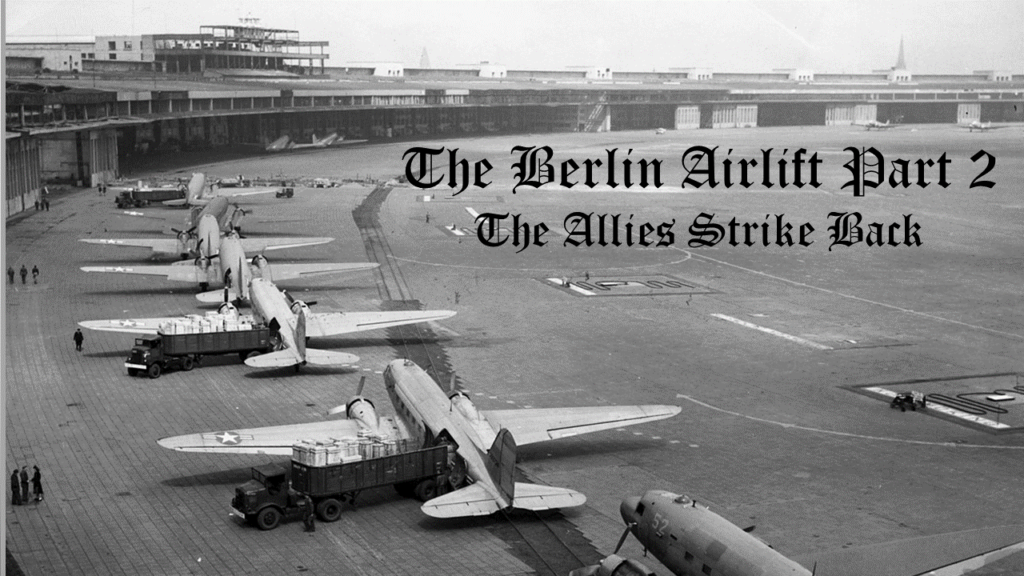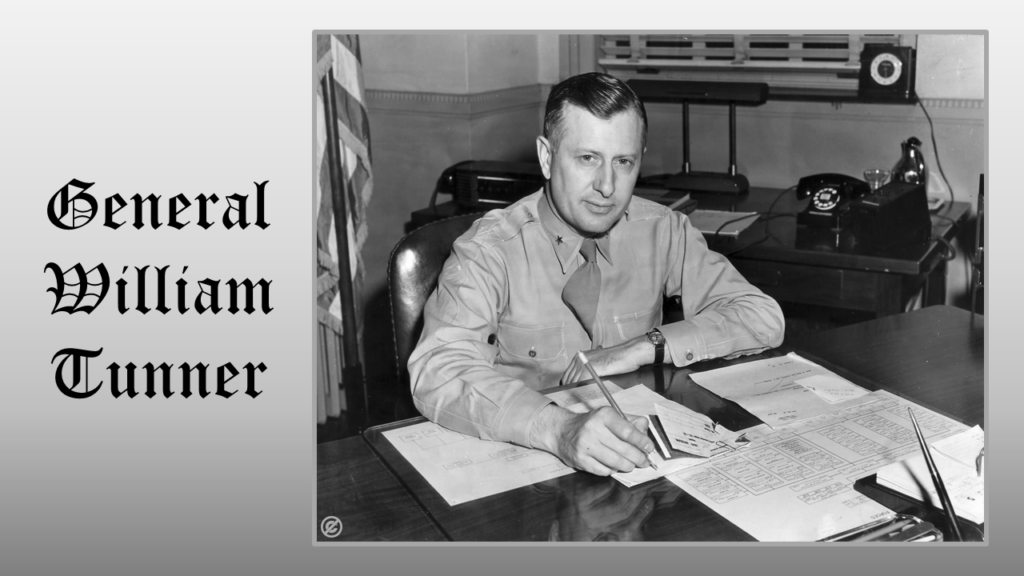
The Berlin Airlift is one of my favorite historical projects, and this is the second of four posts on the topic.
Introduction
With the blockade in place the Soviets were confident that they could force the westerners out of Berlin.
In the western capitals there was consternation and a feeling of inevitability, that they would have to leave Berlin. That possibly it would be better to leave sooner, rather than be seen to be forced out later.
The U.S. Military governor of Germany, General Clay, had been due to retire and control of Germany to pass from the military to the State Department. However, with the looming crisis it was decided that he would remain in post and the transition to civilian governance be postponed.
On the imposition of the blockade Clay proposed driving an armoured column through to Berlin. This solution was so fraught with problems – the most serious of which was war with the USSR*- that it was quickly vetoed by higher authority.
Although there had been regular flights to Berlin, Clay, and Robertson (his British counterpart) decided to use the available aircraft to start ferrying material to Berlin, whilst waiting for a political decision.
The first flight of the airlift took place on June 26th.
A young pilot was ordered to fly to Berlin, although it was already late. On landing in Berlin, he was ordered to make the return flight immediately. Upon his return he was met by his commanding officer who asked how the flights had gone. When he replied, no problem, his CO said, “great, we suspected the Soviets might shoot the plane down.
Welcome to the airlift!
Politics
Although President Truman privately committed to staying in Berlin with his now famous comment, “We stay in Berlin. Period!” there were no forceful public statements. In the absence of public statements from the government Clay and Hawley, (Military Governor of Berlin), did make statements about not being forced out. Within the US political and military establishments there was a general feeling that an airlift would not succeed and would certainly not be a practical solution after the north European winter set in.
With strong encouragement from Ernest Bevin the British Foreign Secretary and the Royal Air Force (RAF), it was decided increase the resources available for the airlift, if nothing else it could buy time till a diplomatic solution was achieved
Clay contacted General Curtis LeMay (Head of the Airforce in Europe) and asked if they could ship coal to Berlin. According to legend, LeMay replied that the air force could ship anything anywhere.
Operation Vittles
LeMay placed General Joseph Smith in charge of the operation, with the comment that it would only be for a few weeks.
Smith named the Airlift “Operation Vittles”, (The British designation was “Plain Fare”) and set about getting more men and planes.
Initially the airlift was operating the older C-47 or Dakota. Indeed, some were still in desert camouflage from the North African campaign, or the black and white striped wings of the D-Day landings. Apart from being old, the main limiting factor of the C-47 was its low payload. Clay and Smith immediately requested the newer and larger C-54s

Crews and aircraft were transferred in from the U.S., and as far afield as Hawaii and Guam. The British were initially able to ramp-up more quickly, due to proximity, but were soon surpassed by the American effort.
As more men and aircraft began to arrive the facilities at the bases were quickly overwhelmed and living conditions deteriorated. Conditions for the families left behind at short notice were also poor and there were inadequate provisions made to ensure the welfare of families, often newly arrived at overseas locations. Very quickly men and machines started to deteriorate, and spares were quickly depleted. The spares stock levels were set for normal operations and not for the round the clock operations now in effect.
Despite all the frantic effort, the airlift was not coming close to the 4,500 tons/day required to meet Berlin’s needs. (1,200 tons/day was the best so far)
With requests for more planes, discussions continued as to the best course of action. Despite President Truman’s “We stay in Berlin. Period!”, the general feeling was that withdrawal was the best option. Few in the military believed that the airlift was viable, and the Airforce did not want to waste resources on what they saw as a forlorn hope. They wanted to get back to the “real” business of the Airforce. There was a genuine concern, that if most of the country’s transport aircraft were in Germany, they could all be destroyed if war occurred, crippling the US war effort.
In addition to the lack of resources the runways in Berlin were deteriorating rapidly.
The main organizational problem was that the operation was being run by “bomber” people, and not Transport Command.
If something did not change the prophets of doom would be proven correct.
The New Man
Did anyone have experience running an airlift?
Happily, YES.
General William Tunner who was, as he put it, currently warming a bench at the Pentagon, had run an extraordinarily successful airlift operation from India to China during WWII.

The Hump
This airlift was called “The Hump” because the route from India to China crossed the Himalayas. The airlift was supporting our Chinese allies who were also fighting the Japanese.

When Tunner took command in September 1944, the Hump was the graveyard of military careers.
The Hump was sustaining casualties higher than those of the bomber group in Europe, and consequently moral and discipline were low.
The route was extremely hazardous and when it was not passing high over the Himalayas it was over impenetrable jungle. Any crews crash landing or bailing out had little chance of survival and recovery.
Tunner was a workaholic and expected the same from his team and would earn the nickname “Willie the Whip”.
Tunner moved in and immediately imposed discipline and structure.
- Aircraft were better maintained
- Crews were better rested
- Crews were trained in safety and jungle survival
- Procedures were put in place
- Targets and statistics were used to control and motivate
Accident rates were lowered even though the number of flights and the overall tonnage increased dramatically. By the end of the war Tunner had created an efficient smooth-running operation.
Berlin
Airforce recognized the need for change and Tunner was appointed to head the Berlin airlift.
With his hand-picked team he headed for Germany, arriving on the 28th of July 1948.
He received a frosty reception from General LeMay. His duties were spelled out and it was made clear to him that he would report through the Airforce command structure and was not to have direct contact with the other services or the civilian authorities.
He and his staff then went to the offices assigned to them. They found a ramshackle building, the rooms bare except for rubbish, and a layer of dust and cobwebs.
A rather inauspicious start.
Could “Willie the Whip” turn things around?
We will continue this extraordinary story in the next blog post, where Willie is assisted by a diverse group of characters; a dispenser of candy, a staunch anti-communist politician, an awesome group of resilient women, and a cartoonist.
Conclusion
The western allies were in a bad situation, they had not anticipated the Soviet move, and had no contingency plans in place. There had been little, or no risk analysis done.
Responsibility for the airlift was initially placed in the hands of a group, who did not believe it could succeed, and did not consider it the “real” work of the Airforce.
Additionally, the group given the task lacked the experience to carry it out. When an experienced team was assigned, they were initially constrained by red tape and rivalry.
What can this teach us as project managers?
- Perform proper risk analysis and have a mitigation plan in place.
- When assigning personnel
- Ensure they are committed to the project
- Ensure they are competent to carry out the work
- Ensure that they get the full support of other departments
- Ensure that they are given support and resources
NOTES
Note: I am using the terms Soviet, Soviet Union, and USSR interchangeably, to indicate the union of communist states governed from Moscow, from 1922 to 1991.

Loving this series Jim. You could not have it justice with only one article. Good call to make it a series.
So many PM lessons to be learned.
Looking forward to the next article.
Awesome teaser: ” … where Willie is assisted by a diverse group of characters; a dispenser of candy, a staunch anti-communist politician, an awesome group of resilient women, and a cartoonist.”
Keep up the good work!
I appreciate the comments and support – Thank you Rashid
Jim
Unbelievably riveting- keep them coming!!!
Thank you for the encouragement Aniela.
I am working on the next post now
Jim
Nice, Jim. And the timeline one part 1 was an eyeopener. Very nice.
Thank for the support Mark. I followed your earlier advice and did the timeline, on Part 1.
There was not enough data points to justify one for Part 2, but there will be one for Part 3.
Hope you keep enjoying the blog
Jim
Great build up. I am anxious to read the next sections.